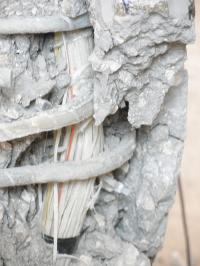Jul 16 2009
Conventional means of internal reinforcement for concrete member in buildings involve steel bars. Yet for structures that function in harsh environments like coastal regions, or for structures that support sensitive equipment, such as magnetic resonance imaging units; the use of fiber reinforced polymer (FRP) is emerging as a valuable option, due to its natural resistance to corrosion, its high strength, light weight, transparency to electrical and magnetic fields and ease of manufacturing and installment.
 This is a photograph of failed specimen. It is a close-up of a failed GFRP tie and bulged bar
This is a photograph of failed specimen. It is a close-up of a failed GFRP tie and bulged bar
However, little has been done to study the performance of concrete columns reinforced with FRP bars. Currently the American Concrete Institute, a nonprofit technical and educational society and one of the world's leading authorities on concrete technology, does not address the use of FRP bars for reinforcement in columns, but welcomes additional relevant research and experimental evidence.
Full-scale experiments are critical to validate the technology, and to produce compelling evidence that underpins rational design methodologies. To address this need, the National Science Foundation (NSF) Industry/University Cooperative Research Center "Repair of Buildings and Bridges with Composites" (RB2C) at the University of Miami (UM) examined the behavior of concrete (RC) columns internally reinforced with glass FRP (GFRP) bars on full-scale specimens for the first time ever.
The new study demonstrates that the behavior of GFRP-RC columns was very similar to that of the conventional steel counterpart. The results of this project will be presented by Antonio De Luca, graduate student at the University of Miami College of Engineering, during the 9th International Symposium on Fiber Reinforced Polymer Reinforcement for Concrete Structures, in Sydney Australia, on July 13-15.
"The outcomes of our study provide a compelling case to modify existing design guidelines and allow for limited use of GFRP bars in columns, particularly when corrosion resistance or electromagnetic transparency is sought," De Luca said.
Other important findings of this project include:
- The GFRP vertical bars are not detrimental for the concrete column performance.
- The contribution of the GFRP to the column capacity is very small, if the amount of longitudinal reinforcement is used. Therefore, the presence of the GFRP bars can be neglected in the computation of the ultimate column capacity.
- Difference in manufacturer of the GFRP bars does not affect the performance when bars are of the same quality.
- Use of GFRP bars as compression reinforcement may be allowed when design is for vertical loads only.
The next stage of the study is meant to demonstrate that specimen scale does not affect GFRP-RC column specimen performance; and to investigate the behavior of GFRP-RC column specimens subjected to compressive load applied with a small eccentricity.